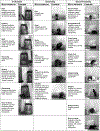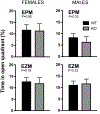Juvenile Shank3b deficient mice present with behavioral phenotype relevant to autism spectrum disorder
- PMID: 30134148
- PMCID: PMC6247805
- DOI: 10.1016/j.bbr.2018.08.005
Juvenile Shank3b deficient mice present with behavioral phenotype relevant to autism spectrum disorder
Abstract
Autism spectrum disorder (ASD) is a pervasive, multifactorial neurodevelopmental disorder diagnosed according to deficits in three behavioral domains: communication, social interaction, and stereotyped/repetitive behaviors. Mutations in Shank genes account for ∼1% of clinical ASD cases with Shank3 being the most common gene variant. In addition to maintaining synapses and facilitating dendritic maturation, Shank genes encode master scaffolding proteins that build core complexes in the postsynaptic densities of glutamatergic synapses. Male mice with a deletion of the PDZ domain of Shank3 (Shank3B KO) were previously shown to display ASD-like behavioral phenotypes with reported self-injurious repetitive grooming and aberrant social interactions. Our goal was to extend these previous findings and use a comprehensive battery of highly detailed ASD-relevant behavioral assays including an assessment of mouse ultrasonic communication carried out on key developmental days and male and female Shank3B KO mice. We demonstrate that ASD-related behaviors, atypical reciprocal social interaction and indiscriminate repetitive grooming, are apparent in juvenile stages of development of Shank3B KO mice. Our findings underscore the importance of utilizing Shank mutant models to understand the impact of this gene in ASD etiology, whichmay enable future studies focusing on etiological gene-environment interactions in ASD.
Keywords: Autism; Autism spectrum disorder; Communication; Shank3; Social behavior.
Copyright © 2018 Elsevier B.V. All rights reserved.
Conflict of interest statement
The authors do not have a conflict of interest to declare.
Figures






Similar articles
-
Replicable in vivo physiological and behavioral phenotypes of the Shank3B null mutant mouse model of autism.Mol Autism. 2017 Jun 15;8:26. doi: 10.1186/s13229-017-0142-z. eCollection 2017. Mol Autism. 2017. PMID: 28638591 Free PMC article.
-
NEXMIF/KIDLIA Knock-out Mouse Demonstrates Autism-Like Behaviors, Memory Deficits, and Impairments in Synapse Formation and Function.J Neurosci. 2020 Jan 2;40(1):237-254. doi: 10.1523/JNEUROSCI.0222-19.2019. Epub 2019 Nov 8. J Neurosci. 2020. PMID: 31704787 Free PMC article.
-
Developmental social communication deficits in the Shank3 rat model of phelan-mcdermid syndrome and autism spectrum disorder.Autism Res. 2018 Apr;11(4):587-601. doi: 10.1002/aur.1925. Epub 2018 Jan 29. Autism Res. 2018. PMID: 29377611 Free PMC article.
-
Comparison of SHANK3 deficiency in animal models: phenotypes, treatment strategies, and translational implications.J Neurodev Disord. 2021 Nov 16;13(1):55. doi: 10.1186/s11689-021-09397-8. J Neurodev Disord. 2021. PMID: 34784886 Free PMC article. Review.
-
Behavioral phenotypes and neurobiological mechanisms in the Shank1 mouse model for autism spectrum disorder: A translational perspective.Behav Brain Res. 2018 Oct 15;352:46-61. doi: 10.1016/j.bbr.2017.09.038. Epub 2017 Sep 28. Behav Brain Res. 2018. PMID: 28963042 Review.
Cited by
-
Ultrasonic vocalizations in mice: relevance for ethologic and neurodevelopmental disorders studies.Neural Regen Res. 2021 Jun;16(6):1158-1167. doi: 10.4103/1673-5374.300340. Neural Regen Res. 2021. PMID: 33269765 Free PMC article. Review.
-
A DLG2 deficiency in mice leads to reduced sociability and increased repetitive behavior accompanied by aberrant synaptic transmission in the dorsal striatum.Mol Autism. 2020 Mar 12;11(1):19. doi: 10.1186/s13229-020-00324-7. Mol Autism. 2020. PMID: 32164788 Free PMC article.
-
Enhanced Glutamatergic Currents at Birth in Shank3 KO Mice.Neural Plast. 2019 Jul 3;2019:2382639. doi: 10.1155/2019/2382639. eCollection 2019. Neural Plast. 2019. PMID: 31354805 Free PMC article.
-
Sex-Dependent Social and Repetitive Behavior and Neurochemical Profile in Mouse Model of Autism Spectrum Disorder.Metabolites. 2022 Jan 12;12(1):71. doi: 10.3390/metabo12010071. Metabolites. 2022. PMID: 35050193 Free PMC article.
-
Hyperthermia elevates brain temperature and improves behavioural signs in animal models of autism spectrum disorder.Mol Autism. 2023 Nov 15;14(1):43. doi: 10.1186/s13229-023-00569-y. Mol Autism. 2023. PMID: 37968722 Free PMC article.
References
-
- APA, Diagnostic and Statistical Manual of Mental Disorders: DSM-5, American Psychiatric Association, Washington, D.C., 2013.
-
- Charman T, Baird G, Practitioner review: Diagnosis of autism spectrum disorder in 2- and 3-year-old children, J Child Psychol Psychiatry 43(3) (2002) 289–305. - PubMed
-
- I. Developmental Disabilities Monitoring Network Surveillance Year Principal, C. Centers for Disease, Prevention, Prevalence of autism spectrum disorder among children aged 8 years - autism and developmental disabilities monitoring network, 11 sites, United States, 2010, MMWR Surveill Summ 63(2) (2014) 1–21. - PubMed
-
- Bailey A, Le Couteur A, Gottesman I, Bolton P, Simonoff E, Yuzda E, Rutter M, Autism as a strongly genetic disorder: evidence from a British twin study, Psychol Med 25(1) (1995) 6377. - PubMed
-
- Hallmayer J, Cleveland S, Torres A, Phillips J, Cohen B, Torigoe T, Miller J, Fedele A, Collins J, Smith K, Lotspeich L, Croen LA, Ozonoff S, Lajonchere C, Grether JK, Risch N, Genetic heritability and shared environmental factors among twin pairs with autism, Arch Gen Psychiatry 68(11) (2011) 1095–102. - PMC - PubMed
Publication types
MeSH terms
Substances
Grants and funding
LinkOut - more resources
Full Text Sources
Other Literature Sources
Medical
Research Materials

